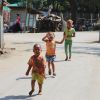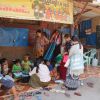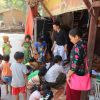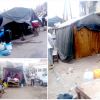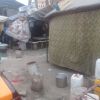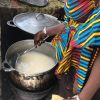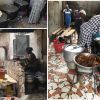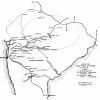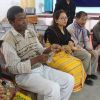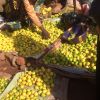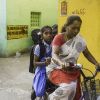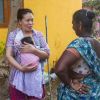The search found 139 results in 0.017 seconds.
Search results
Those kids were coming to us in the village where we were sharing knowledge. They were so happy to learn with us. They were playing around when we first went there.
When I looked at those kids, I felt that they had very little of health education because they were dirty and didn’t even were footwear or slippers. But when they were running to me,I felt how they loved to learn with us. And I felt that I m a useful person and that I was so impressive to them as an educated person. In other words, I learnt to be a little proud of myself.
When I see their slippers, I feel that they are unsystematic. This is where we begin sharing knowledge with them.
ဒီကလေးလ က ဒီေုမိ ျိုး စည်းကမ်းမရှိဖြစ်လေ ာကို ဖြုဖြင်လြးချင်စိ ်လ ဖြစ်မိ ယ်။ ဥြမာ ဒီေုမိ ျိုး စည်းကမ်းမရှိ ဲ့ အဖြစ်မျိုးကို ဖခားနိုင်ငံဖခားသား စ်လယာက်လယာက်ကသာ ဖမင်သ ားရင် ဖမေ်မာေူမျိုးက ဒီေုမိ ျိုးေား ဆို ာမျိုး
မဖမင်လစချင်ဘူး။ အဲေုိ အဖမင်ခံရ ာေည်း များခဲ့ပြ။ီ ထြ်ပြီးလ ာ့ မဖြစ်လစချင် လ ာ့ဘူး။ဒါကကီးကိုဖြင်ြစ်ချင် ဲ့စိ ်လ ဖြစ်ော ယ်။
I just ask them “does it look good when you see your slippers messy?”
They said “No”.
Then, I ask them “how will you solve this problem?”
They said that they will place their slippers systematically.
I understand that they can be changed easily if they have good guidelines. I feel that I can change some parts of their life.
When I see this, I feel that they are not that unaware children. We can encourage them, we can teach them and we can cultivate them. But it is funny that every time when I go there I have to remind them to place their slippers systematically.
But I hope one day this will be become tnatural. Now, most of them have got to the point where they place their slippers systematically. So, I feel that I can do it. I can improve some parts of their life.
In the class, I asked my students that “how does the increasing degree of urbanization change the next generation’s view on localized cultural identity? And how should we as anthropologists collaborate with the community?”
In the class, I discussed on the concept of urban life and then I asked the students to think about the ways in which they all could engage with Taungthaman Village to understand the impact of urban life.
Dr. Akum Longchari is the editor of The Morung Express and has been involved with the people's movements in the areas of human rights, justice, peace, and reconciliation. He also engages actively with the Forum for Naga Reconciliation and is associated with the online community journal, the Naga Republic.
The following is an excerpt from a conversation with Dr Rakhee Kalita Moral.
Dr Imsuchila Kichu is an Assistant Professor of English at Cotton University, Assam. The following is an excerpt from a piece penned by her reflecting upon Naga women and society from the perspective of an insider who has lived away from her community.
Field of Baby's Breath
I wish I could wear
a pretty Pale Pink
ankle-length Calico dress
with frills, flounces and lace,
break out of the mould
abandon the stereotypes
and get into my working clothes
Our brothers are a war
Our land is awash with blood
Our rice fields need tending
Our children caring
Our sick healing
Our streets cleaning
Our enterprises running
Our home fires burning
This is what Monalisa Chankija had to say when we asked her how she views women's freedom in Naga society:
“It seemed that the whole city had turned into a huge market.”
On every street corner various food outlets compete for customers with other types of businesses. Most places have very rudimentary facilities.
"Some have simple tables set out in the open, others stay in the sun while others, like breakfast sellers, join sheets together to make a sort of voting booth in a corner of the street"
On every street corner, too, various street food outlets compete for customers with other types of businesses. These places are either "canteens" or garages of houses transformed into catering spaces with a large table and wooden benches around for customers, or metal or wooden kiosks glued to a wall or by the roadside.
The materials used are numerous: stainless steel or plastic or glass containers, spoons, dishes, a gas bottle or coal furnace, plastic basins for laundry, a few 20-litre oil cans recycled into water reserves and a stack of newspaper used as packaging.
Depending on the time of day, meals with varied menus are served to this very diverse clientele. For breakfast, for example, the saleswomen have bowls on a table, each containing a sauce to make a sandwich, at the customer's discretion, on site or to take away, wrapped in newspaper:
"Arame provides its customers with three long benches. On his table are bowls containing mayonnaise, tuna, pea sauce, spaghetti, French fries, canned meat, ndambé etc. It adds seasonings and spices (chilli, pepper, broth) to foods to suit the taste of customers.
For some vendors the entire preparation chain is a very serious matter, and therefore personal, especially for reasons related to Muslim (halal) precepts:
The rice in the photo is known as "Namar catsa" or " Caca". It looks strange from its name to its colour. According to the farmers, the rice used to be eaten by the Kings and the senior citizens because it is nutritious. The interviewee shared, "it made up complete balanced nutrition for the sick or weak. But now most of our people don't have much knowledge concerning with that kind of paddy ( including me). Today that kind of rice is not grown widely".
Pipariya, as pointed by a number of early settlers of the town, shares its’ initial history with a section of railway line that was laid out during the colonial rule to connect the cities of Bombay (present-day Mumbai) and Calcutta (present-day Kolkata).
The Kokrajhar workshop on rice revealed how urbanization and ‘modern’ non-agricultural lifestyle is putting pressure on the practice of rice cultivation. The space for transmitting indigenous knowledge system is shrinking and rice as a site of knowledge and meaning is being challenged, though it continues to be the main staple in the region. With growing number of younger people migrating to urban areas looking for job opportunities and the gradual spread of urbanization process, the biggest challenge is how to sustain productivitity.
Lemon is a fruit and a small shrub that grows 5 to 10 meters high. It has many benefits, culinary and therapeutic. I like to squeeze a lemon daily when I take tea. On my visit to Leiden, The Netherlands, I bought a lemon at a Saturday Market – one lemon for one Euro - in July 2019.
“A lemon for one Euro” - It was a high price but it made me think about the two different worlds – one in the south, Mali, where I live and a developing region, and the other in the north- the developed region.
Simi Mariya Thomas, Research Scholar, MIDS, selected a photograph from the exhibition, Ambedkar Nagar- Near Kakkan Bridge, Chennai, to write her story for the session on Reading/Writing/Re-writing/Telling/Re-telling using prompts, 20 December 2019.
Superwomen of Chennai always surprise and excite me. They design their life in a manner in which they are fully involved into some sort of activities around the clock.
Simi Mariya Thomas, Research Scholar, MIDS, re-imagined an article circulated as pre-workshop reading in context of her work for the session Reading/Writing/Re-writing/Telling/Re-telling using prompts, 20 December 2019.
The temporary aura of Kannagi statue, in Chennai, which was visible during its installation as well as disappearance made me think about the current media culture.
The two women are as different as chalk and cheese. And I don't mean in terms of skin colour alone. Their appearance distinctly identifies them from two different regions of India - Northeast and South. They speak different languages and cook and eat food vastly different. But they are one - as women, as mothers as sisters in arms. They are united in their strength in the face of adversity. Migration, resettlement and subsistence bring them together in this space. Each is invisible, marginalised and discriminated against - be it colour, caste or communal identity.
Pages

